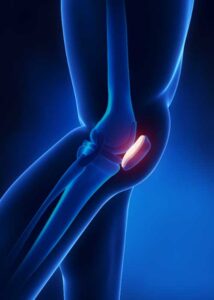Patellofemoral Realignment Surgeon

Are you experiencing pain and stiffness in your knee, especially under or near the kneecap? Have you been previously diagnosed with malalignment syndrome or patellofemoral pain syndrome? If so, you may have arthritis in your knee. Patellofemoral realignment is generally reserved for patients who have a specific type of damage to the knee. Patellofemoral realignment surgeon, Doctor Matthew Provencher provides diagnosis and both surgical and nonsurgical treatment options for patients in Vail who have continued pain from patellofemoral syndrome. Contact Dr. Provencher’s team today!
What is patellofemoral malalignment?
The knee joint is where the patella (kneecap) joins with the femur (thigh bone) and tibia (shin bone). The patella, a sesamoid bone, is anchored to the anterior (front) knee by the quadriceps tendon, attached to the femur, and the patellar tendon that is attached to the tibial tubercle, the bony prominence often associated with the shin bone. Like a train on a track, the patella travels along the trochlear groove, a bony channel located on the distal femur, when the knee flexes and bends. Patellofemoral malalignment is a condition in which several factors can result in patellar displacement and damage to the underlying soft tissue structures of the knee. Such factors can include:
- Shallow trochlear groove (trochlea dysplasia). Individuals with a naturally shallow trochlear groove are more susceptible to patellar displacement that can occur with a minor injury.
- Improper tibial tubercle orientation. If the tibial tubercle, the attachment site for the patellar tendon, is not aligned with the trochlear groove, recurrent patellar displacement can occur.
- Congenital abnormalities. A high-riding patella, known as patella alta, flat feet, or anatomical defects of the patella can increase the risk of patellar malalignment.
- Muscle weaknesses. Any weakness of the quadriceps muscle or the quadriceps tendon can lead to poor tracking of the patella within the trochlear groove.
What is the treatment for patellofemoral malalignment?
When patellofemoral malalignment stems from muscle or tendon weakness, conservative therapies may be sufficient in alleviating symptoms. Participation in a physical rehabilitation program with a specific focus on strengthening the quadriceps muscles, especially the vastus medialis muscle is highly encouraged. However, conservative therapies are not an ideal treatment option for patients with a history of recurrent patellar displacement.
When a patient reports a history of recurrent patellar displacement, surgical intervention provides the best outcome for realigning the patellofemoral compartment. Dr. Matthew T. Provencher, orthopedic knee doctor, treats patients in Vail, Aspen, Colorado Springs, and the Denver, Colorado area who have experienced patellofemoral malalignment and are in need of surgical repair.

How is patellofemoral realignment performed?
There are various surgical procedures that Dr. Provencher can implement to accomplish patellofemoral realignment. The realignment techniques utilized are tailored to the specific patellofemoral malalignment condition and should only be performed by an experienced orthopedic knee surgeon, and are as follows:
- This minimally invasive surgical procedure is preferred by most patients and surgeons as the small incisions allow the surgeons to complete the necessary repairs and the recovery period is shorter for the patient. A small camera (arthroscope) is inserted into the knee joint which enables Dr. Provencher to methodically examine the bones, tendons, ligaments, and cartilage of the knee joint. Any damage identified can be excised and removed with specialized surgical instruments.
- Lateral Retinaculum Release. Located along the lateral (outer) aspect of the patella is a fibrous tissue known as the lateral retinaculum. During an arthroscopic procedure, Dr. Provencher can release this ligament to alleviate any outer knee tension and help reposition the patella. This surgery is most likely performed in combination with additional surgical techniques.
- Tibial Tubercle Osteotomy. In the event of severe patellofemoral malalignment, Dr. Provencher may perform this open surgical procedure to realign the tibial tubercle with the patella. The tibial tubercle, with the patellar tendon attached, is removed from its native anatomical position and shifted into alignment with the patella. The bone is then fastened using surgical screws to keep it in place.
What is the recovery period like after patellofemoral realignment?
Depending on the surgical approach performed by Dr. Provencher, patients can expect a return to normal daily activities in as little as 3 to 4 months or could be as long as 8 to 12 months. The recovery process can also benefit from the patient’s willingness to comply with the post-operative care instructions provided by Dr. Provencher. In general, patients in the Vail, Aspen, Colorado Springs, and the Denver, Colorado area can anticipate the following:
- Limited weight-bearing with the assistance of crutches during the first few weeks following patellofemoral realignment.
- Strenuous physical activity and lifting heavy weights should be avoided for the first couple of months and then slowly increasing activities when appropriate.
- The key to a successful recovery following patellofemoral realignment is active participation and completion of the physical rehabilitation program designed by Dr. Provencher. The physical therapy program will improve the function and range of motion of the knee and strengthen the quadriceps muscle.
For more information on patellofemoral realignment, or to discuss your patellofemoral malalignment treatment options, please contact the office of Matthew T. Provencher, MD, orthopedic knee doctor at The Steadman Clinic, serving Vail, Aspen, Colorado Springs, and the Denver, Colorado area.